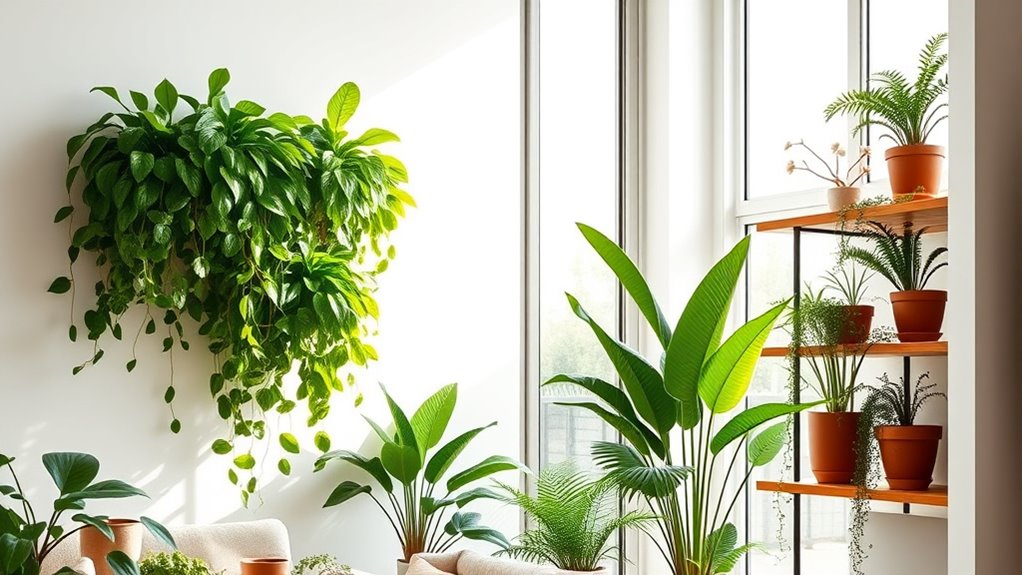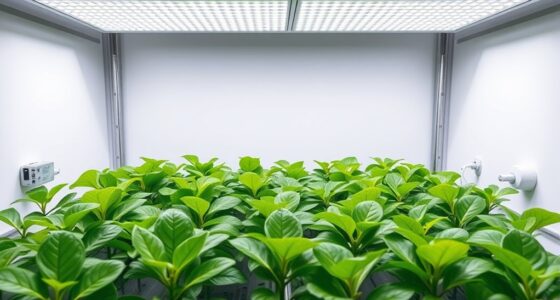Indoor plants in biophilic design create calming, natural environments that boost your mood and reduce stress. By maximizing natural light and arranging greenery thoughtfully, you can improve your mental clarity and emotional stability. Plants also help align your space with nature, fostering relaxation and focus. These elements work together to support overall well-being. To learn more about how plant placement and lighting enhance mental health, keep exploring this fascinating connection.
Key Takeaways
- Indoor plants enhance natural lighting and create dynamic environments that boost mood and reduce stress.
- Strategically placed greenery promotes relaxation, mindfulness, and emotional stability.
- Biophilic design integrates plants to support circadian rhythms, improving sleep and focus.
- Greenery in indoor spaces fosters a sense of connection to nature, enhancing overall well-being.
- Proper space planning with plants encourages mental clarity and reduces feelings of sterility or overwhelm.

Have you ever wondered how integrating natural elements into built environments can boost your well-being? One powerful way to do this is through biophilic design, which brings nature indoors to create healthier, more inviting spaces. Central to this approach is the thoughtful use of natural lighting and strategic space planning. When you maximize natural lighting, you allow sunlight to flood your environment, which not only illuminates the space but also influences your mood and energy levels. Sunlight stimulates the production of serotonin, helping you feel more alert and positive throughout the day. Proper space planning ensures that your indoor plants aren’t just decorative; they become integral to your environment, fostering a sense of calm and connection to nature. When you design your space with plants in mind, you create zones that balance open areas with pockets of greenery, making the environment more engaging and less sterile.
By integrating natural lighting into your space, you also reduce dependence on artificial lights, which can often be harsh or disruptive. Windows, skylights, and well-placed glass walls invite sunlight in at different times of the day, creating dynamic lighting conditions that mimic the outdoors. This not only enhances the aesthetic appeal but also supports your circadian rhythms, helping you sleep better and stay more focused during the day. Space planning plays a vital role here, as it involves arranging your furniture and plant placements to optimize light exposure. Positioning your plants near windows or in zones with ample sunlight allows them to thrive while also providing you with visual benefits. These lush green accents can serve as natural focal points, breaking up monotonous spaces and encouraging mindfulness. Additionally, incorporating projector technology and proper lighting control can further enhance the ambiance, making your environment more conducive to relaxation and mental clarity.
Moreover, good space planning ensures that your indoor plants are accessible and easy to care for, which increases your chances of maintaining them long-term. When plants are thoughtfully integrated into your environment, they don’t just sit passively—they become active elements that influence your daily experience. For example, placing a tall leafy plant next to your workspace can boost concentration and reduce stress, especially if it’s positioned so that you can see it from your seat. The interplay between natural lighting and well-designed space planning creates a harmonious setting that fosters mental clarity and emotional stability. Ultimately, by paying attention to these elements, you cultivate a space that nurtures your mental health, making your environment not just visually appealing but also a sanctuary for your well-being.
Frequently Asked Questions
How Do Indoor Plants Reduce Stress Levels Effectively?
Imagine indoor plants as calming guardians in your space, silently reducing your stress. They work through stress reduction techniques like lowering cortisol levels and improving air quality. To maximize benefits, choose plants with soothing greenery and easy care, using plant selection strategies that suit your environment. By nurturing these green allies, you create a tranquil atmosphere that helps you unwind and feel more centered, effectively easing your daily stress.
Which Plants Are Best for Improving Air Quality Indoors?
You should choose air-purifying, low-maintenance indoor plants like snake plants, pothos, and ZZ plants. These plants effectively filter toxins and improve air quality, making your space healthier. They require minimal care, so you won’t worry about frequent watering or special attention. Incorporating these plants into your home boosts air quality naturally, creating a fresher, more relaxing environment that supports your mental well-being effortlessly.
Can Indoor Plants Boost Productivity at Work?
Think of indoor plants as your productivity partners. They boost focus and creativity by reducing stress and enhancing mood. With the right plant selection, you can create a lively workspace, but remember, maintenance routines are key to keeping them thriving. Regular watering and proper lighting guarantee your plants stay healthy, so your environment remains vibrant and inspiring, ultimately helping you work more efficiently and feel more motivated every day.
Are There Any Health Risks Associated With Certain Indoor Plants?
Yes, there are some health risks associated with certain indoor plants. You should be aware of toxicity concerns, especially if you have pets or children, as some plants can be poisonous if ingested. Additionally, allergen risks are possible with plants that produce pollen or mold, which might trigger allergies or respiratory issues. Always research specific plants before bringing them indoors to guarantee they’re safe for your environment.
How Does Biophilic Design Influence Long-Term Mental Health?
You experience long-term mental health benefits when biophilic design fosters a stronger nature connection. For example, a workplace integrating indoor plants reports reduced stress and improved emotional well-being over time. This connection to nature helps stabilize your mood, enhances focus, and promotes resilience. By consistently surrounding yourself with natural elements, you nurture your emotional well-being, making your environment more calming and supportive for your mental health journey.
Conclusion
You might think adding indoor plants is just a simple decor choice, but they truly boost your mental health. Studies show that surrounding yourself with greenery reduces stress and enhances mood. It’s easy to overlook their impact, but integrating plants into your space can make a real difference. So, don’t dismiss their benefits—embrace biophilic design and create a calmer, happier environment that supports your well-being every day.









